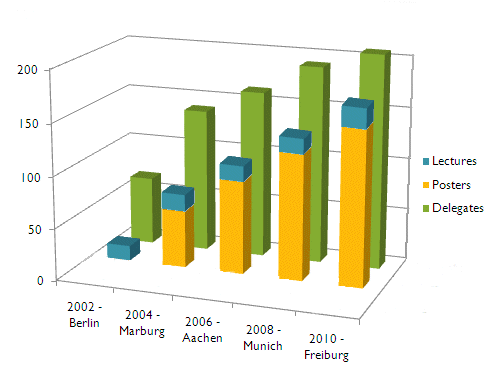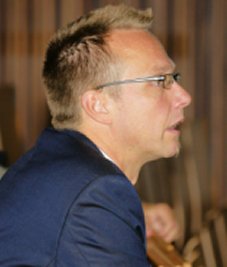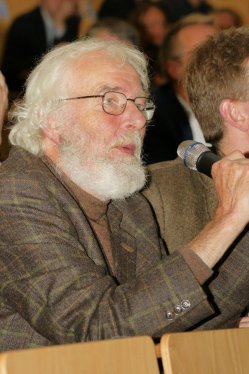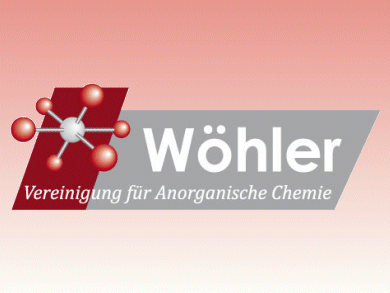Karen Hindson, Editor of the European Journal of Inorganic Chemistry (EurJIC), visited the Wöhler Conference in Freiburg, Germany, and took the opportunity to interview one of the organizers, Professor Ingo Krossing, for ChemViews.
She writes:
Wöhler Conference Gains in Popularity
The Wöhler Association of the Inorganic Division of the German Chemical Society (GDCh) holds a lecture series every two years. In 2010 the conference was held in the Chemistry Institute of the University of Freiburg, Germany, from September 29 – October 1, 2010, and was organized by Professor Ingo Krossing and his team.
.jpg)
Figure 1. Ingo Krossing thanks the team behind the Wöhler Conference.
Judging by the rising interest shown by the numbers of registrants, it is becoming increasingly popular (Figure 2). This year, under the motto “Nothing doing without Inorganic Chemistry!” the trend continued. The conference promised papers on the highly topical themes of energy, catalysis, materials and the related fundamental research.

Figure 2. The Wöhler conference gains in popularity.
The community uses this conference to acknowledge outstanding work in Germany in Inorganic Chemistry and to give young chemists an opportunity to develop skills expected of a professional chemist at international conferences. The session chairpersons were young chemists, who had not filled this office before.
Prizes
Two prizes were awarded: the Alfred Stock Prize was established in 1950 to recognize excellence in experimental research in Inorganic Chemistry and the Wöhler Young Chemist’s award honors an Inorganic Chemist for an outstanding recent publication. In addition to the four keynote lectures on nano metal fluorides, catalysis with organometallics, lithium materials for electromobility, and biomimetic mineralisation, both of the award winners had the opportunity to present their work. Matthias Drieß, winner of the 2010 Alfred Stock prize, highlighted his studies on bond activation without metals through stable silylenes. Jan Weigand discussed the research that led to his publication on cyclo-phosphinophosphonium salts.
Interview with Ingo Krossing

ChemViews: With talks on energy, catalysis, materials and the related fundamental research your team certainly highlighted the fact that there is “Nothing doing without Inorganic Chemistry!” Even before the Wöhler lecture series of 2010 started, you set the scene for an upbeat meeting.
What innovations did you introduce into the series in 2010?
Krossing: The inorganic community always complained that it was not possible to submit talks to the Wöhler Conference. In 2010 the Board of the Wöhler-Vereinigung decided to only invite five keynote lecturers of 45 minutes each and place an open call for speakers for the 15 free slots of 30-minute oral presentations. We received more than double the number of propositions than the number of places available and were thus delighted that we could compose a broad and stimulating program.
Figure 3. Ingo Krossing.
Moreover it is the first time that the Wöhler-Vereinigung decided to organize the conference only using the basic arrangement of the GDCh conference organization. This allowed us to keep prices low and gave us more freedom to organize the meeting.
ChemViews: In what direction is Inorganic Chemistry going in your opinion?
Krossing: The conference demonstrated again that the topical range of Inorganic Chemistry is very broad. This is our strength and interesting for many of us, but also confusing for students and others, because Inorganic Chemistry is not such a homogenous community as others within the chemistry field. We have seen talks from the frontier of fundamental research and learned that these frontiers, which might be ascribed to the ivory tower, may within a decade or two find their entry into application: e.g., see the prize lecture of Prof. Mathias Drieß. We have seen that application always opens new ventures for Inorganic Chemistry, but again the fundamentals have to be analyzed and understood. So it is this bridge between fundamentals that quickly or slowly may find their way into application that defines the direction inorganic chemistry will take in future. A good example clearly is the work on the fluorolytic metal fluoride production by Prof. Erhard Kemnitz that within one decade from purely curiosity driven research matured to something which might be a product in near future.
.jpg)
ChemViews: How have you tried to link these directions with your concept for the Wöhler conference? And what topics were selected in the light of these developments?
Krossing: The goal of the Wöhler Board is to steer the conference to a place where it is “The German Inorganic Chemistry Meeting” that everybody has to attend.
ChemViews: And what topics were selected in the light of these developments?
Due to the above mentioned broad topical range of Inorganic Chemistry, we decided to find a balanced program with which all attendants can identify. This has to be seen in contrast to the multitude of other, rather specialized conferences we have to attend.
Figure 4. Mathais Drieß (left) is awarded the Alfred-Stock prize.
ChemViews: Is the conference interesting for industry?
.jpg)
Krossing: We had a very good industry participation and this is always maintained by the rule that at least one person out of the five to six members of the Wöhler Board has to come from industry. Usually we also have one to two lectures from industry – here the lecture of Prof. Martin Winter on the Frontiers of the Li-Ion batteries was seen as almost an “Industry-contribution” (Forgive me, Martin …!).
ChemViews: Only scientists that had not yet been invited to speak at this conference before were selected for this year’s program. Did you aim to concentrate on young scientists?
Krossing: The rule is that at least 10 years have to pass, before being allowed to talk another time at the conference. This helps in balancing the program and also in focusing on some areas that might otherwise get lost. We did not focus only on young scientists for the lectures, but had the general idea that the conference should be given by about a third of lecturers who are young and a third each in the middle and late stages of their careers. Only the session chairs were selected from the starting scientists that did not present talks.
Figure 5. The “industrial contribution” from Martin Winter.
ChemViews: What expectations did you have for the 2010 Wöhler conference and to what extent were they fulfilled?
Krossing: Being a chair of such a conference puts you quite under pressure and, given the very successful meeting in Munich in 2008, expectations were high. We are very pleased that all expectations were more than met and from many comments during the conference, the members of the board got the impression that we successfully established the brand “Wöhler-Tagung” in Germany. Now we have the pressure to meet the expectations in the future …!
ChemViews: The conference of the Organic Division of the GDCh has been mainly in English for a few years already. Are there plans to follow suit in Inorganic Chemistry and to open this conference to international speakers?

Krossing: In a way, we are already past this temptation. The meetings in Marburg (2004) and Aachen (2006) were given in English. However, when there are only maybe 10 international guests (that usually are fluent in German), it does not make much sense to switch to English. Especially as there was much criticism from the Inorganic Community. So we switched back to German, as this is a German meeting. There are other platforms to present the research in English (EuCheMS, Inorganic Section, AGICHEM and more).
ChemViews: How is the Wöhler Association connected with the AGICHEM conference that will be held in Heidelberg in September 2011?
Krossing: The Wöhler Board is part of the Scientific Committee in Heidelberg and actively decided in 2008 that the conference will be held in Heidelberg.
ChemViews: As an Inorganic Chemist I was particularly pleased to see that at the 3rd EuCheMS Congress in Nuremberg recently there was an important block of Inorganic Chemistry, including a Symposium on Highlights in Inorganic Chemistry, which is not always the case at General Chemistry meetings. Is this a trend that will continue?
Figure 6. Question time.
Krossing: At the GDCh Science Forum meetings there will be significantly more Inorganic Chemistry in future. For instance in 2011, one block out of the now five blocks (in contrast to two in 2009) will jointly be organized with Solid State Chemistry. The remaining four blocks will be covered by other current topics in Inorganic Chemistry.
.jpg)
Figure 7. The lectures generated much discussion.
ChemViews: Thank you very much for your time for this interview.




